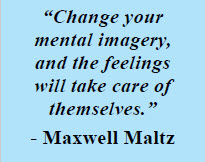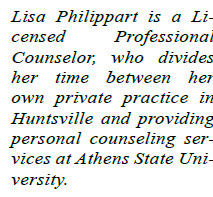 By: Lisa Philippart
By: Lisa Philippart
“A picture is worth a thousand words.” Negative images can lead to more intense distress than thoughts, and we often neglect looking at intrusive imagery, its meaning, and how it affects us. Those who are depressed may have distressing images about past events, or have flash-forwards to a bleak future, or suicidal imagery. Those with anxiety often have intrusive images about a feared future event, seeing the worst possible things happening. And those who have suffered trauma, can have flashbacks, reliving the experiences of those painful memories. It makes sense that using therapeutic imagery would be most effective at helping those who suffer from distressing imagery. Some call it “mental time travel.” The aim of imagery techniques is to change the toxic meaning of the image, reducing the distress.
There are four types of imagery techniques:
- Imagery Manipulation is altering aspects of and reducing the distress associated with any image, which will enable you to cope with the image during daily life.
- Imagery Rescripting is changing the content and outcome of troubling and intrusive imagery, either from a past memory or future event.
- Compassionate Nurturing Imagery involves promoting self-compassion.
- Imagery Rehearsal is mentally rehearsing a feared imagined future event.
 Before working with imagery, you need to establish an imaginary Safe Place. This is a place you can return to at any time when the images become too distressing. I encourage clients to “build” a safe place, and practice going to that place, so that it feels almost natural when a serious situation arises. Some ideas for such a safe place in your imagination include: a lake, island, beach, mountain, meadow, forest, river, cottage, ship, hot-air balloon, a world from a favorite book or movie, etc.
Before working with imagery, you need to establish an imaginary Safe Place. This is a place you can return to at any time when the images become too distressing. I encourage clients to “build” a safe place, and practice going to that place, so that it feels almost natural when a serious situation arises. Some ideas for such a safe place in your imagination include: a lake, island, beach, mountain, meadow, forest, river, cottage, ship, hot-air balloon, a world from a favorite book or movie, etc.
Start each imagery exercise with relaxation. Make yourself comfortable in a chair with your arms and legs supported and uncrossed. Close your eyes and notice the sensation of feeling supported by the chair, and the floor beneath your feet. Bring your attention to your breathing, maybe imagining that you have a balloon in your belly…notice the sensations as the balloon inflates on the in-breath and deflates on the out-breath. Now practice going to your safe place. Just let yourself be there in the moment.
 Finish each visualization by taking a few moments to bring your attention back into the here and now of where you are. Whenever you are ready, open your eyes and bring your attention back to the room. Again, notice the chair supporting you and look around you, pay attention to what you see and hear, now, in the room. Take a few balloon breaths. Check in with yourself to see how you feel.
Finish each visualization by taking a few moments to bring your attention back into the here and now of where you are. Whenever you are ready, open your eyes and bring your attention back to the room. Again, notice the chair supporting you and look around you, pay attention to what you see and hear, now, in the room. Take a few balloon breaths. Check in with yourself to see how you feel.
Part of the effectiveness of working with imagery is being able to identify the images that you experience. For example, can you describe the qualities of your images? Referring to your safe place, what are the colors you see, the sounds and smells, what is your field/observer perspective? Take a moment to register your emotional response, putting words to how you feel. Maybe you are able to assign meaning or interpretation to the image. For example, a hot-air balloon lifts you above your “problems,” giving you a whole new perspective. We often have a physical or behavioral response to our images. Can you identify that type of reaction…a fluttering in your stomach, a lowering of your shoulders, or a slowing of your breathing?
Work on finding your safe place and practice going there. In my next article, we will begin to examine the four imagery techniques to reduce or eliminate your painful thoughts or memories.
By: Lisa Philippart
Licensed Professional Counselor







